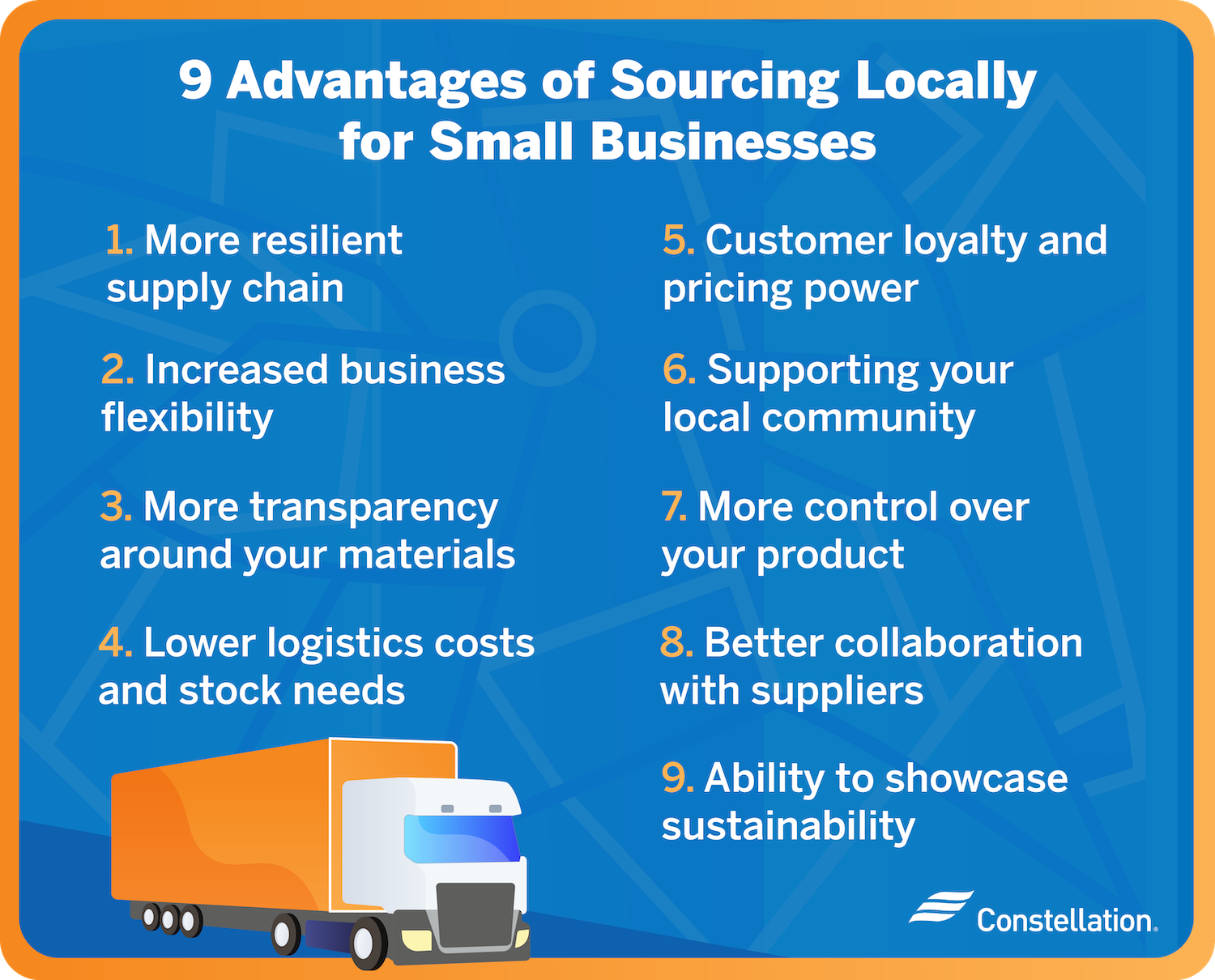
- Category:
Small Business Energy Savings -
Last updated:
July 30, 2025
Benefits of Local Sourcing for Your Business
Local sourcing is becoming increasingly appealing to small businesses, as relying on distant suppliers can expose you to tariffs, supply chain disruptions and high shipping costs that threaten both operations and profitability.
Local sourcing can help lower your business’s carbon footprint, too. Roughly 90% of your environmental impact comes from your supply chain. Working with local suppliers benefits the local economy, supporting jobs and strengthening business networks.
A local supply chain can benefit your reputation and sales, as well. 77% of Americans prefer products made in the United States, with 82% saying they would buy more U.S.-made goods if they were easier to find.
Here, we’ll explore how local sourcing works, its key advantages and how to decide if it’s the right fit for your business.
What is local sourcing?
Local sourcing refers to getting supplies and production inputs from suppliers within 100 miles of your operation. By doing this, you could help minimize shipping distance, costs, time and energy usage. Local sourcing also makes you less dependent on a long and complex supply chain that’s vulnerable to disruption.
Is local sourcing more sustainable?
Yes, local sourcing is more sustainable because it reduces the fossil fuels used for shipping. Locally sourced materials also require less packaging, reducing waste. These aspects translate into reduced emissions and a lower carbon footprint.
With local sourcing, you can:
- Reduce transportation emissions: Eliminating shipping miles reduces transportation-related fuel usage. Freight shipping accounts for 14% of all global carbon emissions.
- Limit energy consumption: Buying locally can cut fossil fuel consumption by 40%. If you don’t need specialized storage, such as refrigeration or additional processing, your energy usage is reduced even further.
- Support local climate and biodiversity: Local sourcing helps to create jobs and contributes to the local business community, strengthening networks and enhancing resilience. For food ingredients or natural materials, local suppliers can support biodiversity.
- Strengthen quality control: Using local suppliers that care about their reputation grants you greater transparency and accountability.
Top benefits of local sourcing for small businesses
Local sourcing benefits can positively impact your business in multiple ways:
1. More resilient supply chain
Simple, short supply chains are less vulnerable to war, port congestion, tariffs and economic disruption that put your business at risk of running out of inputs, slowing or even stopping operations. 82% of companies that invested in a local sourcing strategy enjoyed more resilience in their supply chains.
2. Increased business flexibility
Being able to turn on a dime when the market shifts or supply chains are disrupted means you can thrive when others fall behind. Scale up or down, launch new products and quickly adapt to changing customer needs with suppliers as agile as you are.
3. More transparency around your materials
When you’re close enough to visit facilities and talk directly to producers, you can keep an eye on your materials. Understand suppliers’ processes, spot issues early and make ethical choices. Know what goes into your products to be more confident and transparent.
4. Lower logistics costs and stock needs
Lowering your logistics and inventory costs increases your operational efficiency. You can schedule small shipments more often, with fast delivery for efficient inventory management. This removes the costs of ocean freight and long-haul shipping, while also avoiding import taxes and fees. And because you won’t have as much inventory risk, you won’t need safety stock and warehousing fees.

5. Customer loyalty and pricing power
60% of Americans are willing to go out of their way to support local businesses. And studies show that 42% will pay a premium to buy local. Let customers know about your commitment to local sourcing in order to differentiate from competitors and increase loyalty.
6. Support for your local community
Local sourcing benefits your local community in meaningful ways. Studies show that 52.9%–64.1% of locally earned revenue recirculates locally. Every $100 spent locally leads to an additional $45 in local spending. Support local jobs and build a network of business relationships that can help businesses innovate and grow.
7. More control over your product
Local suppliers care about their reputations, standing behind what they sell. When you source locally, you have greater power to customize specifications. Local sourcing also enables frequent inspections that ensure goods are up to standard, and damage during shipping is less likely.
8. Better collaboration with suppliers
Collaborating face-to-face frequently is a significant benefit of local sourcing. With strong, trusted relationships, you may get mutually beneficial terms like eliminating minimum order requirements. And if things go wrong, a foreign company is much harder to collect from.
9. Ability to showcase sustainability
Sustainability sets your company apart. Transportation is the largest source of greenhouse gas emissions, accounting for 28% of the total emissions in the U.S. Reducing shipping of inputs, even using hyperlocal sourcing, lowers your carbon footprint.
Telling your small business sustainability story is something your customers or clients may appreciate and reward.
What are the risks of sourcing locally?
Given the benefits of local sourcing, what are the downsides? Before adopting a local sourcing strategy, think through some of the risks and challenges. These include:
- Potentially higher costs: Cheap prices offered by overseas and national suppliers originally drove the move away from local sourcing. Nearby suppliers may not be able to match those prices.
- Limited product and material variety: You have fewer choices of what is available nearby, compared to innovations and options elsewhere.
- Efficiency issues: Smaller local suppliers may not have the capacity of national or international suppliers.
- Overdependency: A supplier that is overdependent on you may spend less to innovate. If you are highly dependent on a single supplier, you lose price leverage.
- Failures are more public: Pulling your business from a locally popular supplier may cause backlash. If you have a dispute with them, it may attract negative attention.
- Local vulnerabilities: A natural disaster, local economic troubles, or political policies that affect your business may also damage your suppliers.
Getting started with local suppliers
Take a step-by-step approach to building a strong and sustainable local supply chain:
- Analyze which products can be sourced locally: Examine popular items and consider what inputs may be locally available.
- Research and find local suppliers: Use online directories, attend trade shows and network to find local suppliers.
- Build strong relationships: Once you identify possible suppliers, visit their operations, ask detailed questions and check references.
- Start with small changes: Make incremental changes, testing quality, tracking pricing and monitoring adherence to specifications and terms as you go.
- Highlight local sourcing in your marketing: Tell your customers with messaging like “Made Nearby” badges on your packaging, website and sales collateral to let people know you support the local community.
Combine local sourcing with energy efficiency
Sourcing nearby to your operations contributes to caring for the environment. Local sourcing cuts costly long-distance transportation and reduces your carbon footprint.
You can further trim your budget and emissions by running an energy-smart business using local suppliers. This strengthens your community, enhances the resilience of your operations and sets you up to thrive in the long term.




